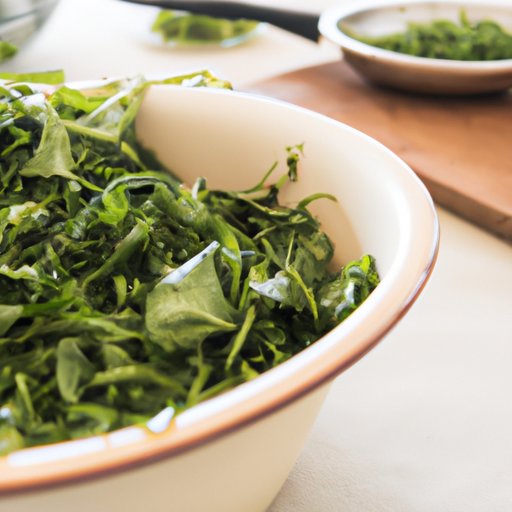
I. Introduction
Turnip greens might not be the first thing that comes to mind when thinking of greens, but they are a delicious, nutritious and versatile choice befitting of any meal. Whether you are a seasoned cook or a beginner, this guide is for anyone who wants to learn how to cook turnip greens like a pro.
II. The basics: A step-by-step guide
To achieve perfect turnip greens, start by prepping the greens. Rinse each leaf in cold water and trim any tough ends or stalks. If you are using young leaves, you can cook them whole, but for mature leaves, chop them into smaller pieces.
Next, place the greens in a large pot and cover them with water. Bring the water to a boil, and then add any seasonings you like, such as salt, pepper, garlic, or onion powder. After that, bring the heat to a simmer and let the greens cook. The cooking time varies depending on the leaves’ maturity, but it usually takes around 15-30 minutes.
Once they are cooked, remove the greens from the heat and drain the excess water. Serve them as a side dish or as a base for salads or soups.
To enhance the dish, add bacon, ham hocks, or smoked turkey for that extra flavor. And for vegans or vegetarians, use vegetable broth instead of meat broth and add some smoked paprika or liquid smoke to simulate a smoky flavor.
III. Comparing cooking methods
Boiling is the most popular cooking method for turnip greens, but there are other ways to prepare this nutritious vegetable.
Another way is to sauté the greens with some oil and garlic or onion to elevate their taste. Stir-frying is another option that results in a crispy and delightful texture.
Lastly, baking the greens can provide an excellent complement to various dishes when seasoned with cheese or breadcrumbs. Whatever method you choose, there are pros and cons, but the choice is yours to taste the difference.
IV. Pairings and recipes
Now that you’ve learned how to cook them, let’s explore some fantastic recipe ideas for turnip greens.
The classic pairing for turnip greens is smoked ham or bacon. This is an irresistible combination of smoky, salty, and savory flavors. It’s also a perfect way to start experimenting with different seasoning and spices.
Adding turnip greens to soups and stews is another great way to incorporate this powerhouse vegetable into your meals. You can add them to slow-cooked dishes such as collard greens, or you can combine them with other vegetables, such as carrots, potatoes, and onions, to make a nutrient-packed soup.
If you prefer more variety, you can add turnip greens to a stir-fry dish or grain bowl to increase the health benefits and ingredients. Or you can fry or bake them as a side dish to enjoy that crispy and crunchy bite.
V. Health benefits and preparation
Not only are turnip greens delicious, but they are also packed with valuable nutrients that can promote better health by supporting an array of body functions.
They are rich in antioxidants, fiber, vitamins, and minerals, including Vitamin C, K, A, calcium, and iron. Moreover, they are low in calories and do not add much to your daily caloric intake. Eating turnip greens regularly can lead to strengthened immunity, healthy digestion, and strong bones.
Preparing turnip greens is relatively easy, and there are several ways you can do it to maximize their nutritional potential. For instance, boiling or steaming them can retain more of their vitamins and minerals than other cooking methods, such as deep-frying.
You can also pair them with other nutrient-rich foods to create a winning combination. For example, adding vitamin-C-rich ingredients, like bell peppers or citrus fruits, when cooking turnip greens can boost iron absorption in your body. Also, turnip greens are popular among detox and cleanse diets for their health attributes.
VI. Regional cuisine
Turnip greens are a popular part of many regional cuisines worldwide and used in various dishes. Here are some examples:
– Southern-style turnip greens: A classic Southern preparation that simmers the greens with ham hocks or bacon and onions, resulting in a tasty, comforting, and homey dish.
– African and Caribbean recipes: Many African and Caribbean dishes use turnip greens and their closest relative, collard greens (or sukuma wiki), as a staple food. They are usually cooked with coconut milk and spices to create a luxurious and healthy meal.
– Asian-inspired dishes: Turnip greens are utilized in many Asian dishes, such as Japanese miso soup or Chinese stir-fry. They are also a prevalent choice in Vietnamese, Indian, and Korean cuisines.
VII. Conclusion
Turnip greens are a nutritious, adaptable, and tasty ingredient to experiment with in your cooking. Whether boiled, sautéed, baked, or stir-fried, there are numerous cooking methods that will bring out their unique flavor. Pairings and recipes offer endless inspiration, while the nutritional benefits and preparation techniques can help you achieve a healthier lifestyle. Finally, regional cuisines are the perfect source for new and innovative recipes. Share your tips and recipes in the comments and enjoy your delicious and nutritious turnip greens.




